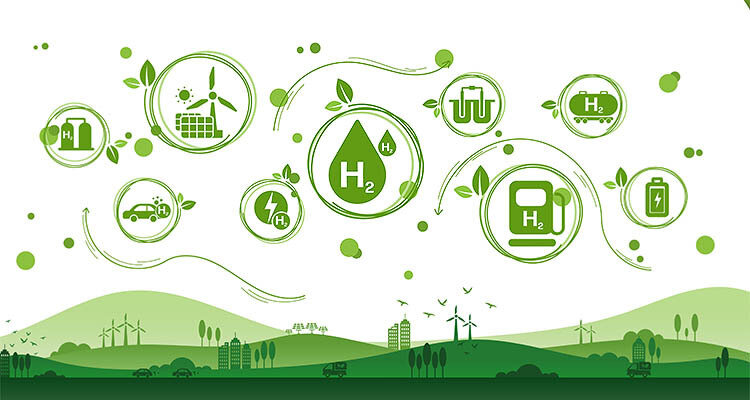
Buff Lopez analyzes the challenges facing the adoption of low-carbon hydrogen as a fuel source
Global demand for low-carbon hydrogen is predicted to rise steadily – although it accounted for less than one percent of the total hydrogen production in 2022 (IEA). By 2030, demand increases are estimated to reach 150 Mt and 520 Mt in 2050 – but a lot will depend on the policy environment and other factors, according to a study by Cleantech Group. An estimated $80bn – $300bn will be required to build the global low-carbon hydrogen economy by 2030.
Varieties of hydrogen
Hydrogen occurs in many forms, with each offering varied options and challenges. Naturally occurring hydrogen – dubbed ‘gold’ when found underground, and ‘white’ when identified in depleted oil wells – could be among the cheapest at less than $1/kilogram.
‘Turquoise’ hydrogen, produced by methane pyrolysis, has the potential to be carbon negative and offers carbon black as a byproduct.
Green hydrogen, produced with renewable energy, is growing fast but poses challenges to scale up.
Companies with nuclear assets have the opportunity to produce ‘pink’ hydrogen using electrolysis, and ‘purple’ hydrogen with thermolysis.

Produced with at least 80 percent lower emissions than fossil fuels, low-carbon hydrogen costs up to three times more than alternatives, but robust policy support including direct financial incentives, can help it become competitive. Low-carbon hydrogen could gain a 14 percent share of global energy demand by 2050, according to the IEA.
By 2030, innovation – supplemented by subsidies – is expected to cut the cost of low-carbon hydrogen production by 80 percent. Supportive policy environments in places like Australia, the US and the EU will help give an initial boost to building out the necessary infrastructure required.
Many countries are targeting a $1-$3/kilogram goal, with higher carbon prices even enabling low-carbon hydrogen cost parity with fossil fuel equivalents in some geographies, such as the EU. Still, challenges abound, notably in building a global hydrogen economy.
To keep delivered costs of hydrogen down, local infrastructure will need to be retrofitted or re-purposed (upgrading pipelines, using existing transport networks, etc.). Where this is impossible, production will need to be localized or centralized near its end use. An estimated 50 percent of the landed costs are due to transportation requirements.
The US DoE’s $8bn hydrogen hubs will advance key projects in the US, but other projects that are ready to be resourceful without the same funding can still succeed long-term. But while government support will be required for the initial boost of hydrogen much like it was for solar and wind, it will be sustained by the private sector.
For this to happen, project producers need to be realistic with their offtake capacity, improve cost transparency, and collaborate with other ecosystem players. This will help reduce some of the associated risks around new project development and ideally drive up the venture investment needed.
Technologies to produce low-carbon hydrogen are set to hit manufacturing lines en masse in 2024. But delivering cost-competitive hydrogen will require a reduction in component costs. Long-term cost efficiencies will require more R&D and embracing of abundant materials in production technologies, even if requiring some trade-offs on durability.
For example, concerns about the use of critical raw materials in catalysts for electrolysis has prompted the development of new catalysts not comprised of the typical platinum-group family. In Europe, the EIC Pathfinder challenge is investigating carbon-based catalysts, among other routes, as novel synthesis routes for catalysts for green hydrogen production.
Delivering at-scale means the industry will need to overcome serious technical midstream challenges. Other areas of opportunity that are often overlooked include controls monitoring and safety technology that are critical to cost efficiency and operational stability.
In 2022, venture investors poured a record $2.41bn into hydrogen ventures, including $300m on Monolith, which has developed methane pyrolysis technology to split natural gas into carbon and hydrogen gas on a commercial scale. This year, the industry is on course for a lower $1.92bn. Overall, green hydrogen is the best funded segment, with $954m, followed by hydrogen pyrolysis with $300.1m.
Hydrogen start-ups are bringing innovation to address the twin challenges of reducing costs and raising efficiencies. In production, Aurora Hydrogen is using plasma at high temperatures to reduce CO2, while Plagazi is tapping different waste feedstocks. Similarly, Getech is using subsurface imaging to tap natural hydrogen.
Sinoscience Fullcryo raised $110.5m in August to increase equipment manufacturing. Interestingly, they do not necessarily have any deeptech innovation that dramatically differentiates them from competitors. Rather, they act as a sort of one-stop shop for large-scale cryogenic solutions of hydrogen. At this relatively early stage of building out the hydrogen economy, some investors are more interested in who can gain the greatest control of a developing value-chain.
Increased penetration of low-carbon hydrogen can have far-reaching impact across broad swathes of the economy. It can help decarbonize hard-to-abate industries, such as heavy-duty trucking (six percent of global CO2 emissions), steel production (nine percent of CO2), and aviation (2.4 percent of CO2). Green ammonia for fertilizer production is the nearest-term offtake market since no custom facilities will be required for its transportation and it has the lowest cost barrier for producers.
Where electrification is possible, hydrogen should not be considered as a viable energy source. In small- to medium-sized EVs and passenger vehicles, batteries will win out over fuel cells. Similarly, for domestic heating, electric heat pumps will win out over hydrogen heating systems and furnaces.
For a list of the sources used in this article, please contact the editor.
Buff Lopez is a Research Analyst at Cleantech® Group, a research-driven company that helps corporates, public sector, investors, and others, identify, assess, and engage with the innovative solutions and opportunities that are related to the world’s massive, and growing, environmental and climate challenges. Its insights and expertise are delivered to clients all over the world through research, consulting, and events. It has been the leading authority on global cleantech innovation since 2002.